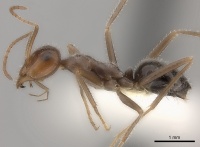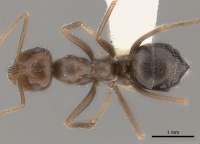Myrmecocystus intonsus
| Myrmecocystus intonsus | |
|---|---|

| |
| Scientific classification | |
| Kingdom: | Animalia |
| Phylum: | Arthropoda |
| Class: | Insecta |
| Order: | Hymenoptera |
| Family: | Formicidae |
| Subfamily: | Formicinae |
| Tribe: | Lasiini |
| Genus: | Myrmecocystus |
| Subgenus: | Endiodioctes |
| Species group: | melliger |
| Species: | M. intonsus |
| Binomial name | |
| Myrmecocystus intonsus Snelling, R.R., 1976 | |
This species has only been collected a few times and little is known about its biology.
| At a Glance | • Replete Workers |
Identification
A member of the melliger group of the Myrmecoystus subgenus Endiodioctes.
Key to Myrmecocystus subgenus Endiodioctes species.
Abundantly hairy, with ten or more fully erect hairs on malar area in frontal view and on scape, femora and tibiae; erect pronotal hairs blunt, stiff, short, longest hairs less than 0.5 x MOD; HW of majors less than 1.7 mm, head of majors orbiculate; third tergum shiny, with scattered pubescence.
This ant appears to be a depauperate derivative of Myrmecocystus placodops which it closely resembles, especially in the strongly orbiculate head of the major workers. In addition to the much smaller size it differs from placodops, and other species in the melliger group, by the sparsely pubescent third and fourth terga. There is also a resemblance to such species as Myrmecocystus koso and Myrmecocystus romainei in the romainei group, but these have far fewer erect hairs on the malar area and the longest pronotal hairs are, in the major workers, more than 0.5 x MOD. (Snelling 1976)
Keys including this Species
Distribution
Mexico. Known only from southern Baja California Sur.
Latitudinal Distribution Pattern
Latitudinal Range: 34.648792° to 20.702394°.
| North Temperate |
North Subtropical |
Tropical | South Subtropical |
South Temperate |
- Source: AntMaps
Distribution based on Regional Taxon Lists
Neotropical Region: Mexico (type locality).
Distribution based on AntMaps
Distribution based on AntWeb specimens
Check data from AntWeb
Countries Occupied
| Number of countries occupied by this species based on AntWiki Regional Taxon Lists. In general, fewer countries occupied indicates a narrower range, while more countries indicates a more widespread species. |

|
Estimated Abundance
| Relative abundance based on number of AntMaps records per species (this species within the purple bar). Fewer records (to the left) indicates a less abundant/encountered species while more records (to the right) indicates more abundant/encountered species. |

|
Biology
The type series was taken from a nest in sandy soil at the edge of an arroyo in a dense stand of mixed cardon, mesquite and palo blanco. The crateriform tumulus was about 4 ½” diam. Workers were actively foraging at midday, ambient temperature approximately 70°F, returning with miscellaneous insect fragments. Other ant species taken at this station: Pogonomyrmex californicus (Buckley), Pheidole vistana, Solenopsis xyloni, Conomyrma bicolor (Wheeler) and Forelius foetidus (Buckley).
At 72 mi NW of La Paz, the site was an alkali playa with mesquite and cholla. A single worker was found here, shortly before sunset, at secretory glands on cholla. Other ant species encountered were: Pseudomyrmex sp.; Veromessor juliana (Pergande), Crematogaster coarctata (as californica), Xiphomyrmex spinosus Pergande, Acromyrmex versicolor (Pergande), Camponotus mina Forel and C. festinatus (Buckley).
Workers were observed also near La Burrera and Todos Santos. Nests were situated in sandy soil and were surmounted by low, regularly crateriform tumuli. One exceptional nest had the entrance sited in a clump of grass. Foragers were active during the hot part of the day in early October, with ambiant midday temperatures in excess of 90°F. Many workers were seen at the flowers of a prostrate Euphorbia.
Castes
Known only from workers.
Phylogeny
| Myrmecocystus |
| |||||||||||||||||||||||||||||||||||||||||||||||||||||||||||||||||||||||||||||||||||||||||||||||||||||||||||||||||||||||||||||||||||||||||||||||||||||||||||||||||||||||||||||||||||||||||||||||||||||||||||||||||||||||||||||||||||||||||||||||||||||||||||||||||||||
Based on van Elst et al. (2021).
Nomenclature
The following information is derived from Barry Bolton's Online Catalogue of the Ants of the World.
- intonsus. Myrmecocystus (Endiodioctes) intonsus Snelling, R.R. 1976: 30, figs. 70-72 (w.) MEXICO.
Unless otherwise noted the text for the remainder of this section is reported from the publication that includes the original description.
Description
Worker
Measurements. HL 1.00-1.70 (1.70); HW 0.86-1.63 (1.63); SL 1.06-1.60 (1.60); WL 1.3-2.2 (2.2); PW 0.63-1.06 (1.06).
Head: Longer than broad to broader than long in larger workers, CI 86-102 (96); shorter, to longer, than scape, SI 96-131 (98). In frontal view widest at lower eye margin in small workers, the sides straight and slightly convergent toward mandibular bases; in progressively larger workers widest point becomes lower and sides more convex, largest workers with strongly orbiculate head. Occiput, in frontal view, flattened in middle, broadly rounded onto sides, not at all angulate. Eye small, barely longer than first flagellomere; OMD 1.50-2.00 (1.91) x EL. Mandible septendentate.
Thorax: Moderately robust, PW 0.44-0.56 (0.46) x WL. Smaller workers with distinct, flattened basal propodeal face, broadly rounded into longer posterior face; larger workers with basal face convex and merging into posterior face.
Petiole: In profile, thick, posterior face flat, anterior face abruptly sloping toward crest in upper third, crest narrowly rounded; in frontal view crest flat or slightly convex; from above, about 1.5 x wider than long.
Vestiture: Pubescence sparse on most of head, a little denser on occiput, conspicuously denser on frontal lobes; dense on thorax; dense and conspicuous on discs of first two terga; sparse on sides of first two terga and on all of remaining segments.
Erect hairs abundant on head, with ten or more present on malar area in frontal view; longest occipital hairs half, or more, as long as minimum eye diameter. Erect thoracic hairs abundant on all dorsal faces and posterior face of propodeum; longest pronotal hairs less than half minimum eye diameter; mesonotal hairs about as long as those of propodeum. Petiolar scale with numerous short hairs on marginal surfaces. Terga with abundant discal hairs, progressively longer on succeeding segments, those of first segment shorter than hairs of hind tibia. Appendages abundantly hairy; scape with hairs on all faces; fore femur with at least ten erect hairs on inner face.
Integument: Head moderately shiny, all areas, including clypeus, lightly shagreened; frontal lobes densely and finely punctate; clypeus with sparse, coarse, setigerous punctures; head elsewhere with scattered fine, shallow punctures. Thorax slightly shiny, closely and coarsely shagreened, propodeum duller. First two terga slightly shiny, densely shagreened, with scattered setigerous punctures and coarse poriform punctures; third and following segments shiny, subpolished, very lightly shagreened, with sparse fine punctures.
Color: Head and alitrunk dark brownish ferruginous; mandibles and lower half, or less, of face yellowish; propodeum often more infuscated; gaster blackish; appendages lighter than thorax.
Type Material
Holotype and 151 worker paratypes: 12.4 mi S La Paz, 100', Baja California Sur, MEXICO, 2 March 1969 (R. R. Snelling; No. 69-71); holotype and most paratypes in Los Angeles County Museum of Natural History; three paratypes to each of the following: American Museum of Natural History, GCW, Museum of Comparative Zoology, National Museum of Natural History.
Etymology
L., intonsus, unshaved, having reference to the abundance of erect hairs on all surfaces.
References
- Alatorre-Bracamontes, C.E., Vásquez-Bolaños, M. 2010. Lista comentada de las hormigas (Hymenoptera: Formicidae) del norte de México. Dugesiana 17(1): 9-36.
- Sankey-Alamilla, L.R.A., Hernandez-Jimenez, S.A., Lopez-Reyes, E., Ceccarelli, F.S. 2024. New species of honeypot ant of the genus Myrmecocystus from Pacific coastal dunes of Baja California, Mexico. Southwestern Entomologist 49(1), 71-87 (doi:10.3958/059.049.0107).
- Snelling, R. R. 1976. A revision of the honey ants, genus Myrmecocystus (Hymenoptera: Formicidae). Nat. Hist. Mus. Los Angel. Cty. Sci. Bull. 24: 1-163 (page 30, figs. 70-72 worker described)
- van Elst, T., Eriksson, T.H., Gadau, J., Johnson, R.A., Rabeling, C., Taylor, J.E., Borowiec, M.L. 2021. Comprehensive phylogeny of Myrmecocystus honey ants highlights cryptic diversity and infers evolution during aridification of the American Southwest. Molecular Phylogenetics and Evolution 155, 107036 (doi:10.1016/j.ympev.2020.107036).
References based on Global Ant Biodiversity Informatics
- Alatorre-Bracamontes, C.E. and M Vasquez-Bolanos. 2010. Lista comentada de las hormigas (Hymenoptera: Formicidae) del norte de México. Dugesiana 17(1):9-36
- Dattilo W. et al. 2019. MEXICO ANTS: incidence and abundance along the Nearctic-Neotropical interface. Ecology https://doi.org/10.1002/ecy.2944
- Fernandes, P.R. XXXX. Los hormigas del suelo en Mexico: Diversidad, distribucion e importancia (Hymenoptera: Formicidae).
- Johnson, R.A. and P.S. Ward. 2002. Biogeography and endemism of ants (Hymenoptera: Formicidae) in Baja California, Mexico: a first overview. Journal of Biogeography 29:10091026/
- Snelling R. R. 1982. A revision of the honey ants, genus Myrmecocystus, first supplement (Hymenoptera: Formicidae). Bulletin of the Southern California Academy of Sciences 81: 69-86
- Snelling, R.R. 1982. A revision of the honey ants, genus Myrmecocystus, first supplement (Hymenoptera: Formicidae) Bulletin of the Southern California Academy of Sciences 81(2):69-86
- Vásquez-Bolaños M. 2011. Lista de especies de hormigas (Hymenoptera: Formicidae) para México. Dugesiana 18: 95-133



